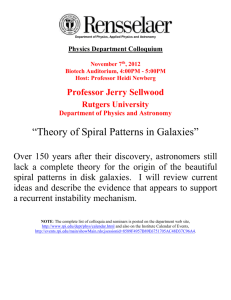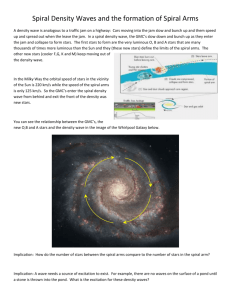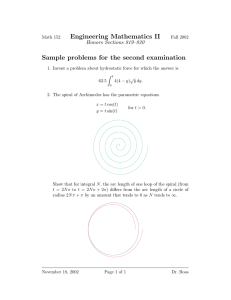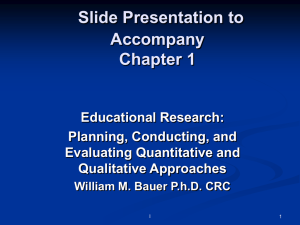Dynamical Evolution of Disk Galaxies
advertisement
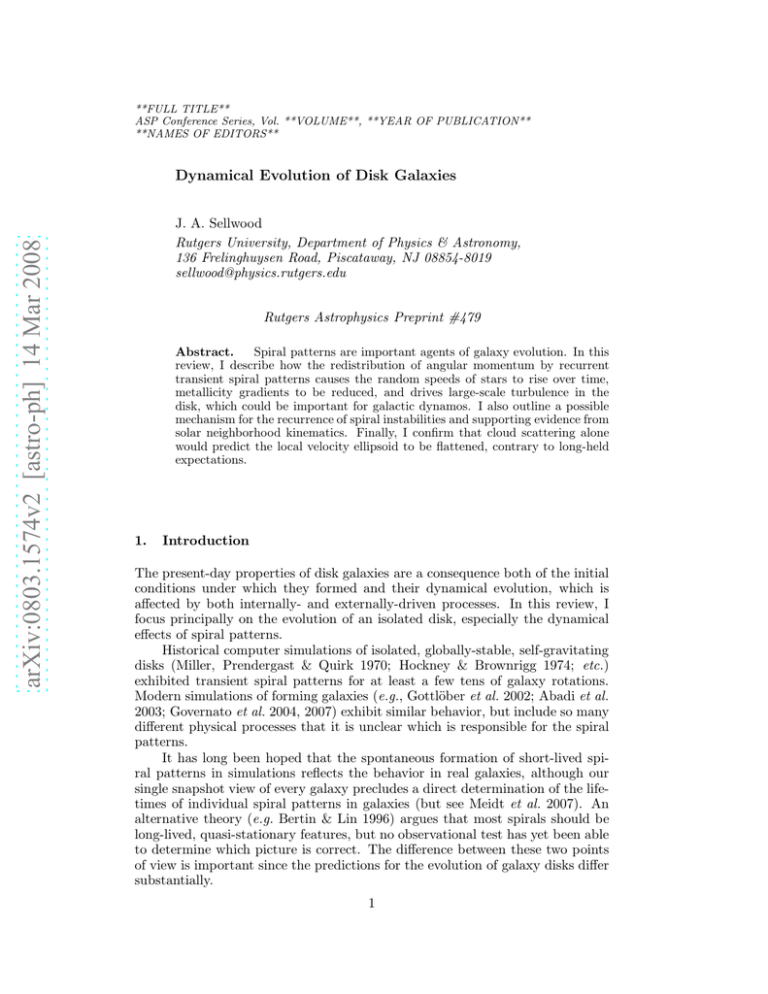
**FULL TITLE** ASP Conference Series, Vol. **VOLUME**, **YEAR OF PUBLICATION** **NAMES OF EDITORS** arXiv:0803.1574v2 [astro-ph] 14 Mar 2008 Dynamical Evolution of Disk Galaxies J. A. Sellwood Rutgers University, Department of Physics & Astronomy, 136 Frelinghuysen Road, Piscataway, NJ 08854-8019 sellwood@physics.rutgers.edu Rutgers Astrophysics Preprint #479 Abstract. Spiral patterns are important agents of galaxy evolution. In this review, I describe how the redistribution of angular momentum by recurrent transient spiral patterns causes the random speeds of stars to rise over time, metallicity gradients to be reduced, and drives large-scale turbulence in the disk, which could be important for galactic dynamos. I also outline a possible mechanism for the recurrence of spiral instabilities and supporting evidence from solar neighborhood kinematics. Finally, I confirm that cloud scattering alone would predict the local velocity ellipsoid to be flattened, contrary to long-held expectations. 1. Introduction The present-day properties of disk galaxies are a consequence both of the initial conditions under which they formed and their dynamical evolution, which is affected by both internally- and externally-driven processes. In this review, I focus principally on the evolution of an isolated disk, especially the dynamical effects of spiral patterns. Historical computer simulations of isolated, globally-stable, self-gravitating disks (Miller, Prendergast & Quirk 1970; Hockney & Brownrigg 1974; etc.) exhibited transient spiral patterns for at least a few tens of galaxy rotations. Modern simulations of forming galaxies (e.g., Gottlöber et al. 2002; Abadi et al. 2003; Governato et al. 2004, 2007) exhibit similar behavior, but include so many different physical processes that it is unclear which is responsible for the spiral patterns. It has long been hoped that the spontaneous formation of short-lived spiral patterns in simulations reflects the behavior in real galaxies, although our single snapshot view of every galaxy precludes a direct determination of the lifetimes of individual spiral patterns in galaxies (but see Meidt et al. 2007). An alternative theory (e.g. Bertin & Lin 1996) argues that most spirals should be long-lived, quasi-stationary features, but no observational test has yet been able to determine which picture is correct. The difference between these two points of view is important since the predictions for the evolution of galaxy disks differ substantially. 1 2 2. Sellwood Dynamical consequences of short-lived spiral patterns Angular momentum transport is the principal driver of galaxy evolution by spiral patterns. Not only does it change the radial distribution of mass within the disk, especially near the outer edge (e.g. Ros̆kar et al. 2008), but it also drives increasing velocity dispersions and radial mixing within the disk. In all these ways, recurrent transient spiral patterns have a greater impact on the evolution of galaxy disks than do long-lived waves. It might seem that if the time-averaged amplitude and pitch angle of transient spirals did not differ much from those of a steady long-lived pattern, the gravity torques and angular momentum changes would be similar. However, the gravitational stresses caused by long-lived patterns that invoke feed-back via the long-wave branch of the dispersion relation (see ch. 6 of Binney & Tremaine 2008, hereafter BTII) transport less angular momentum because the complicating advective transport term (aka “lorry transport” Lynden-Bell & Kalnajs 1972; BTII, Appendix J) greatly reduces the angular momentum flux. Furthermore, since evolutionary angular momentum exchanges between the stars and the wave take place at resonances, large changes induced by a long-lived pattern would be confined to a few narrow resonances, the most important of which, the inner Lindblad resonance, is “shielded.” On the other hand, multiple, shortlived disturbances having a range of pattern speeds over the same time interval share the exchanges over large parts of the disk because their resonances are broader and have more numerous locations. 2.1. The importance of gas Sellwood & Carlberg (1984) showed that recurrent transient spiral patterns fade after about 10 galaxy rotation periods because the time-dependent gravitational potential fluctuations caused by the spirals themselves scatter the disk particles away from circular orbits at broad resonances (Carlberg & Sellwood 1985). It becomes harder to organize coherent spiral density variations as the velocity dispersion of the disk particles rises; spiral activity in a disk of particles is therefore self-limiting. They also showed that spirals could recur indefinitely only if some of the effects of gas dissipation and star formation were included in the calculations (see also Carlberg & Freedman 1985 and Toomre 1990), and the results from modern work are consistent with this picture. The build up of random motion is resisted in the dissipative component, and the formation of new stars with small peculiar velocities at the rate of a few per year is enough to maintain spiral activity in the entire disk. Spiral patterns are prominent only in galaxies containing significant gas from which stars are forming; lenticular galaxies are mostly gas free and have little in the way of spiral features. Recurrent transient spiral behavior offers a natural, though not the only possible, explanation of this fact. 2.2. Age-velocity dispersion relation The velocity dispersions of solar neighborhood stars reveal an increasing trend when they are arranged by age (Wielen 1977; Nordström et al. 2004) or, for mainsequence stars, by color (Dehnen & Binney 1998). I am unqualified to contribute to the on-going discussion (e.g. Holmberg et al. 2007 and references therein) of Dynamical Evolution of Disks 3 the accuracy of stellar age estimates adopted by Edvaardson et al. (1993) and Nordström et al. (2004), but errors of order unity would be required to totally vitiate the dynamical significance of their results. Possible smaller errors of up to 20% in individual stellar ages do not affect the dynamical implications of their results. Spitzer & Schwarzschild (1953) proposed scattering by massive clouds of gas, before even their discovery, as the dynamical origin of the general increase of random motion with age – the age-velocity dispersion relation. Lacey (1984) extended their analysis to 3-D and concluded (see also Lacey 1991) that the observed molecular clouds could not account for the magnitude of the increase to that of the oldest stars. Stars are also scattered by transient spiral waves (Barbanis & Woltjer 1967; Carlberg & Sellwood 1986). Lacey (1991) concluded that transient spirals were a promising mechanism to account for the higher dispersion of the older stars, although other ideas may not be ruled out. 2.3. Dispersion of stellar metallicities with age Edvaardson et al. (1993), and others, have reported that older stars in the solar neighborhood have a spread of metallicities that is inconsistent with the idea that they all formed at the solar radius from gas that was gradually becoming more metal rich over time. This result is more critically dependent on age estimates, although errors would have to be of order unity to reduce the reported spread to a tight correlation, which would also make the Sun a truly exceptional star. Sellwood & Binney (2002) showed that radial migration of stars driven by recurrent, transient spiral waves in fact provides a natural explanation for the metallicity spread of stars with age. They showed that the galactocentric radius of a star can migrate by up to 2 kpc in either direction as a result of “surfing” near the corotation radius of an individual spiral pattern. The combined effects of multiple spiral patterns leads to radial mixing of stars without an associated increase in the velocity dispersion. Long-lived spiral waves would not achieve a quasi-steady diffusion, since stars on horse-shoe type orbits near corotation would alternate between two mean radii, preventing the radial diffusion that is needed to account for the increasing range of metallicities with age. 2.4. Large-scale turbulence Precisely the same mechanism that causes radial mixing of the stars creates large-scale turbulence in the ISM. Gas in the vicinity of corotation is driven by a spiral pattern, radially inwards by ∼ 1 kpc at some azimuths and outwards by a similar amount at others. The radially-shifted gas eventually mixes with other gas (e.g. Sellwood & Preto 2002, fig. 9) at its new radius. Spiral-driven mixing in the ISM may also help with the well-known problem posed by the large-scale (ordered) component of B-fields in galaxies (e.g. Rees 1994). Standard αΩ-dynamo theory (Parker 1955) is thought to yield too low a growth rate to achieve the present-day observed field strengths (Beck et al. 1996) from the likely seed fields. The growth-rate is proportional to the geometric mean of the rates of galactic shear (the Ω term) and cyclonic circulation (the α term) (Kulsrud 1999). Current estimates of the α-term are based on supernovae-driven turbulence (Ferrière 1998; Balsara & Kim 2005), but spiral- 4 Sellwood driven turbulence should enhance the α-effect substantially, and thereby increase the growth-rate obtainable from the dynamo. 3. Mechanism for recurrent transient spirals The spiral patterns in computer simulations of isolated disks must be self-excited. However, without an understanding of their origin, they could all be dismissed as arising from some unknown numerical artifact, perhaps related to the small number of particles (Bertin & Lin 1996). If true, such a skeptical viewpoint would require spirals in real galaxies to have a different origin, though they need not necessarily be long-lived; a possible alternative universal mechanism for recurrent transient spirals could be forcing by substructure in the dark matter halos, as reported by Dubinski (these proceedings). The development of short-lived spiral features has not changed over the years as the numerical quality of simulations has improved. Codes have held up under extensive testing (Sellwood 1983; Inagaki, Nishida & Sellwood 1984; Sellwood & Athanassoula 1986; Earn & Sellwood 1995; Sellwood & Evans 2001), but a successful test in one problem is no guarantee of the code’s performance in other problems. I have recently (Sellwood, in preparation) conducted a suite of simulations of a stable Mestel disk model with particle numbers ranging up to N = 5 × 108 . Simulations of a linearly stable disk should manifest no structure exceeding that expected from amplified particle noise. However, I find evidence that the linear theory prediction fails whenever the disturbance amplitude exceeds ∼ 2% of the undisturbed density. Again this could be an important physical result or another manifestation of the supposed artifact, although the greatest particle number is now only 2 orders of magnitude below the number of stars in a disk. The most effective way to counter this dismissive viewpoint would be to understand the mechanism for recurrent spiral generation in simulations and to find evidence that the process also works in nature. I (Sellwood 2000) outlined a possible mechanism for recurrent spiral generation in collisionless particle disks, but observational evidence to support it was lacking. However, the detailed phase-space structure of stars in the solar neighborhood, as revealed in the monumental study of local F & G dwarfs by Nordström et al. (2004) has opened the door to empirical tests. Clearly, data from the upcoming GAIA mission will be even more useful. The central idea of the recurrence mechanism is that scattering of stars at the principal resonances of the spiral pattern (e.g. BTII) changes the distribution function (DF) in such a way as to seed the growth of a new instability in the disk. Each instability is caused by locally steep gradients in the DF, supported vigorously by the response of the surrounding disk (Sellwood & Kahn 1991). The spiral wave grows until non-linear effects become important, and Sellwood & Binney (2002) showed that the onset of horse-shoe orbits at corotation causes the disturbance to begin to disperse. At this moment, all the action stored in the wave is carried away to the Lindblad resonances at the group velocity where stars are scattered to create the conditions for a new instability. While the idea is simply stated, many of the details remain to be worked out. Dynamical Evolution of Disks 5 Support for this idea comes from analysis of the velocity distribution of 13 240 nearby F & G dwarf stars in the Geneva-Copenhagen sample (Nordström et al. 2004). The distribution of stars in phase space is very far from smooth, as originally noted by Dehnen (1998), but is broken into various “star streams,” which cannot simply be dissolved star clusters (Famaey et al. 2006; Bensby et al. 2007), with no underlying smooth component. Some of these features have been modeled as scattering by the bar (Kalnajs 1991; Dehnen 2000) or by spirals (Yu & Tremaine 2002) or a combination of both (Quillen & Minchev 2005), but all these studies modeled the velocity-space distribution, not integral-space, and none was self-consistent. The substructure in the DF is too complicated to have a single origin, and such ideas could be responsible for one or more of the features. I find (in preparation) that the local DF, when plotted as a function of energy and angular momentum, contains at least one clear feature of high statistical significance that appears to have resulted from either scattering or trapping at a resonance. Analysis of the sample in action-angle variables reveals that it is an inner Lindblad resonance that has most recently sculptured the local DF, which is exactly the feature Sellwood (1994) predicted might be observable in such a sample. If the mechanism invoked to interpret the behavior of simulations does indeed appear to occur in the Milky Way, then the entire picture stands on much firmer ground. 4. Velocity Ellipsoid Shape I conclude with an attempt to resolve an old dispute about the axis ratio of the local velocity ellipsoid expected from scattering by giant molecular clouds. Though a side issue to the main thread of this brief review, it has provided an additional, apparently compelling, argument in favor of spirals as short-lived transients that now turns out to have no weight. Lacey (1984) and Binney & Lacey (1988) calculated the separate growth of the in-plane and vertical components, concluding that cloud scattering should cause the vertical component to be intermediate between the radial and azimuthal components. Their result seems physically plausible on energy equipartition grounds: scattering by massive clouds redirects the peculiar motions of stars through random angles, and therefore isotropizes the motions as far as is possible. However, this is not what is observed. The second moments of the velocity distribution of solar neighborhood stars in the three orthogonal directions are unequal (Wielen 1977; Dehnen & Binney 1998; Nordström et al. 2004). The radial component, σu , is the largest, the azimuthal component, σv , intermediate and the vertical component, σw , is the smallest, and this remains true for all groups when the stars are subdivided according to the best estimates of their ages. The ratio of the two in-plane components is set by the epicyclic motions, and is in reasonable agreement with theoretical expectations (e.g. Dehnen & Binney 1998). Some estimates of the velocity ellipsoid shape in external galaxies are beginning to be made (Gerssen et al. 1997, 2000; Ciardullo et al. 2004; Westfall et al., these proceedings). 6 Sellwood Carlberg (1987) and Jenkins & Binney (1990) therefore developed the plausible argument that spirals drive up the in-plane components more rapidly than scattering is able to redirect those motions into the vertical direction, thereby accounting for the observed axis ratios of the velocity ellipsoid. Their argument appeared to offer strong support for the transient spiral picture, but this particular line of argument now seems to be incorrect. The conclusion by Lacey (1984) and Binney & Lacey (1988) that cloud scattering would lead to the vertical dispersion being intermediate between the radial and azimuthal dispersions was challenged by Ida, Kokuba & Makino (1993). These authors claimed that cloud scattering alone would lead to the vertical component being the smallest, as confirmed in numerical simulations (Shiidsuke & Ida 1999). Ida et al. ( 1993) also show how the axis ratio depends on the local slope of the rotation curve. Their two papers have attracted little attention, largely because they are hard to follow, and their physical explanation for their different conclusion is rather enigmatic. Accordingly, I here describe some idealized simulations to determine what should be the shape of the velocity ellipsoid due to scattering by randomly distributed, co-orbiting mass clumps. 4.1. Idealized simulations I wish to study the motion of collisionless stars in an axisymmetric disk potential that is smooth except for the presence of a collection of non-interacting scattering masses. I treat the stars as test particles moving in an axisymmetric, vertically stratified, potential and integrate their motion subject to perturbations from a collection of co-moving heavy particles. Following Wisdom & Tremaine (1988) for a Keplerian disk and Toomre & Kalnajs (1991) for a constant-velocity disk, I consider a small orbiting patch of the disk, with periodic boundary conditions and adjacent radial boxes sliding past the main box at the local shear rate. These authors describe the set-up of sheared sheet simulations more fully. I assume a flat rotation curve for the in-plane accelerations, while the vertical density profile has the form ρ(z) = ρ0 sech2 (z/2z0 ) for the isothermal sheet (Spitzer 1942; BTII). The heavy particles, which contain 20% of the local surface density, affect the vertical balance and I reduce the nominal surface mass density that gives rise to the fixed potential by the mass in the heavies, which are distributed in a thinner layer. The heavy particles all start with random motions that are 5% of those of the test particles, with a corresponding reduction in the thickness of the layer of heavies. I have verified that the final shape of the velocity ellipsoid is insensitive to the fraction of mass in the heavy particles or their velocity dispersions. The initial in-plane velocities of the test particles are set such that, were the disk self-gravitating, Toomre’s Q = 1 and the epicycle approximation requires σu = 21/2 σv . There can be no asymmetric drift in the sheared sheet, since the symmetry of the equations does not determine the direction to the center of the galaxy. The initial vertical positions and speeds of all test particles are set to ensure vertical balance. The principal parameter I vary is the initial vertical velocity dispersion of the test particles. The scale height is related to 2 /(2πGΣ). As the vertical motions of the test particles the dispersion as z0 = σw rise, I make corresponding adjustments to the scale height of the potential, Dynamical Evolution of Disks 7 Figure 1. The effect on the equilibrium axis ratio of the velocity ellipsoid of limiting the range of the perturbation forces from the heavy particles. although the final shape of the velocity ellipsoid is little affected by turning this refinement on or off. I adopt the usual Plummer potential for each heavy particle, with a softening length of 0.01R0 , where R0 is our fourth the radial extent of the sheared patch under study. The maximum range of the perturbing forces from the heavy particles in the adopted shearing box arrangement that can be conveniently handled is the radial extent of the box. The position of every heavy particle is duplicated in the surrounding boxes and the perturbing forces from all the heavy particles and their images separately affect the motion of the test particles in the main box. 4.2. Results As the integration proceeds, the shape of the velocity ellipsoid of the test particles evolves towards a steady value, while the total magnitude of the velocity dispersion rises slowly. I find that irrespective of whether I begin with a round or strongly flattened velocity ellipsoid, it quickly evolves to a shape in which the vertical dispersion is slightly smaller than the azimuthal dispersion. The final ellipsiod shape is always σu : σv : σw ≃ 1 : 0.71 : 0.62, confirming the prediction by Ida and coworkers, and in disagreement with the results by Lacey and Binney & Lacey. The physically plausible energy equipartition argument must also be misleading. It seemed possible that this prediction fails in a thin disk because the distribution of scatterers is not uniform. As with any scattering process in 3-D, the ln Λ term implies that distant encounters dominate. But distant scatterers in the flattened geometry of a disk are not isotropically distributed, and scattering 8 Sellwood by distant clouds must predominantly affect the in-plane star velocities, and couple much less strongly to the vertical component. In order to test this idea, I experimented with excluding the influence of the disturbance forces from all heavy particles more distant than dmax . Figure 1 shows the equilibrium ratio σw /σu plotted as a function of dmax . The ratio settles to something close to the energy equipartition prediction when none but the closest heavy scatterers perturb the stars, but as I increase the range of scattering in separate experiments, the final ellipsoid gradually becomes flatter and approaches Ida’s result for no cut off. This test therefore clearly supports the idea that the anisotropic distribution of the scatterers determines the equilibrium shape of the velocity ellipsoid. Previous studies (Spitzer & Schwarschild 1953; Lacey 1984; Binney & Lacey 1988) assumed that scattering is dominated by impact parameters that are small compared to both the epicycle radius and the disk thickness and peculiar velocities were the most important. Thus the shape of the local velocity ellipsoid (e.g. Nordström et al. 2004) is apparently consistent with cloud scattering, and its origin does not require concurrent spiral arm scattering, as seemed attractive. However, the data do not imply that spirals are unimportant: there are hints of some evolution of the velocity ellipsoid shape that may demand a compound origin, and the magnitude of the random speeds of the oldest stars may still require an additional source of scattering (e.g. Lacey 1991). Acknowledgments. I thank Scott Tremaine for insisting that I should better understand the reason for the shape of the local velocity ellipsoid, and for some helpful correspondence. I thank Cedric Lacey, Ray Carlberg, Victor Debattista and especially James Binney for perceptive comments on the manuscript. This work was supported by grants AST-0507323 from the NSF and NNG05GC29G from NASA. References Abadi, M. G., Navarro, J. F., Steinmetz, M. & Eke, V. R. 2003, ApJ, 597, 21 Balsara, D. S. & Kim, J. 2005, ApJ, 634, 390 Barbanis, B. & Woltjer, L. 1967, ApJ, 150, 461 Beck, R., Brandenburg, A., Moss, D., Shukurov, A. & Sokoloff, D. 1996, ARA&A, 34, 155 Bensby, T., Oey, M. S., Feltzing, S. & Gustafsson, B. 2007, ApJ, 655, L89 Bertin, G. & Lin, C. C. 1996, Spiral Structure in Galaxies (Cambridge: The MIT Press) Binney, J., Dehnen, W. & Bertelli, G. 2000, MNRAS, 318, 658 Binney, J. J. & Lacey, C. G. 1988, MNRAS, 230, 597 Binney, J. & Tremaine, S. 2008, Galactic Dynamics, 2nd edition (Princeton: Princeton University Press), (BTII) Carlberg, R. G. 1987, ApJ, 322, 59 Carlberg, R. G. & Freedman, W. L. 1985, ApJ, 298, 486 Carlberg, R. G. & Sellwood, J. A. 1985, ApJ, 292, 79 Ciardullo, R., Durrell, P. R., Laychak, M. B., Herrmann, K. A., Moody, K., Jacoby, G. H. & Feldmeier, J. J. 2004, ApJ, 614, 167 Dehnen, W. 1998, AJ, 115, 2384 Dynamical Evolution of Disks 9 Dehnen, W. 2000, AJ, 119, 800 Dehnen, W. & Binney, J. J. 1998, MNRAS, 298, 387 Earn, D. J. D. & Sellwood, J. A. 1995, ApJ, 451, 533 Edvardsson, B., Andersen, B., Gustafsson, B., Lambert, D. L., Nissen, P. E. & Tomkin, J. 1993, A&A, 275, 101 Famaey, B., Pont, F., Luri, X., Udry, S., Mayor, M. & Jorrissen, A. 2007, A&A, 461, 957 Ferrière, K. 1998, A&A, 335, 488 Gerssen, J., Kuijken, K. & Merrifield, M. R. 1997, MNRAS, 288, 618 Gerssen, J., Kuijken, K. & Merrifield, M. R. 2000, MNRAS, 317, 545 Gottlöber, S., Klypin, A., Kravtsov, A., Hoffman, Y. & Faltenbacher, A. 2002, astro-ph/0208398 Governato, F., Mayer, L., Wadsley, J., Gardner, J. P., Willman, B., Hayashi, E., Quinn, T., Stadel, J. & Lake, G. 2004, ApJ, 607, 688 Governato, F., Willman, B., Mayer, L., Brooks, A., Stinson, G., Valenzuela, O., Wadsley, J. & Quinn, T. 2007, MNRAS, 374, 1479 Hockney, R. W. & Brownrigg, D. R. K. 1974, MNRAS, 167, 351 Holmberg, J., Nordstrom, B. & Andersen, J. 2007, A&A, 475, 519 Ida, S., Kokuba, E. & Makino, J. 1993, MNRAS, 263, 875 Inagaki, S., Nishida, M. T. & Sellwood, J. A. 1984, MNRAS, 210, 589 Jenkins, A. & Binney, J. J. 1990, MNRAS, 245, 305 Kalnajs, A. J. 1991, in Dynamics of Disc Galaxies, ed. B. Sundelius (Gothenburg: Göteborgs University) p. 323 Kulsrud, R. M. 1999, ARA&A, 37, 37 Lacey, C. G. 1984, MNRAS, 208, 687 Lacey, C. G. 1991, in Dynamics of Disc Galaxies, ed. B. Sundelius (Gothenburg: Göteborgs University) p. 257 Lacey, C. G. & Ostriker, J. P. 1985, ApJ, 299, 633 Lynden-Bell, D. & Kalnajs, A. J. 1972, MNRAS, 157, 1 Meidt, S. E., Rand, R. J., Merrifield, M. R., Debattista, V. P. & Shen, J. 2007, ApJ, to appear (arXiv:0711.4104) Miller, R. H., Prendergast, K. H. & Quirk, W. J. 1970, ApJ, 161, 903 Nordström, B., Mayor, M., Andersen, J., Holmberg, J., Pont, F., Jørgensen, B. R., Olsen, E. H., Udry, S. & Mowlavi, N. 2004, A&A, 418, 989 Parker, E. N. 1955, ApJ, 122, 293 Quillen, A. C. & Minchev, I. 2005, AJ, 130, 576 Rees, M. 1994, in Cosmical Magnetism, p. 155, ed. by D. Lynden-Bell (NATO ASI, Volume 422) Ros̆kar, R., Debattista, V. P., Stinson, G. S., Quinn, T. R., Kaufmann, T. & Wadsley, J. 2008, ApJ, 675, L65 Sellwood, J. A. 1983, J. Comp. Phys., 50, 337 Sellwood, J. A. 1994, in Galactic and Solar System Optical Astrometry ed L Morrison (Cambridge: Cambridge Univ. Press) p. 156 Sellwood, J. A. 2000, in Astrophysical Dynamics – in Commemoration of F. D. Kahn, eds. D. Berry, D. Breitschwerdt, A. da Costa & J. E. Dyson, Ap&SS, 272, 31 (astro-ph/9909093) Sellwood, J. A. & Athanassoula, E. 1986, MNRAS, 221, 195 Sellwood, J. A. & Binney, J. J. 2002, MNRAS, 336, 785 Sellwood, J. A. & Carlberg, R. G. 1984, ApJ, 282, 61 10 Sellwood Sellwood, J. A. & Evans, N. W. 2001, ApJ, 546, 176 Sellwood, J. A. & Kahn, F. D. 1991, MNRAS, 250, 278 Sellwood, J. A. & Preto, M. 2002, in Disks of Galaxies: Kinematics, Dynamics and Perturbations, p. 281, eds. Athanassoula, E., Bosma, A. & Mujica, R. (ASP Conf. Ser. 275) Shiidsuke, K. & Ida, S. 1999, MNRAS, 307, 737 Spitzer, L. 1942, ApJ, 95, 329 Spitzer, L. & Schwarzschild, M. 1953, ApJ, 118, 106 Toomre, A. 1990, in Dynamics & Interactions of Galaxies, p. 292, ed. Wielen, R., Springer-Verlag:Berlin, Heidelberg. Toomre, A. & Kalnajs, A. J. 1991, in Dynamics of Disc Galaxies, p. 341, ed. B. Sundelius (Gothenburg: Göteborgs University) Wielen, R. 1977, A&A, 60, 263 Wisdom, J. & Tremaine, S. 1988, AJ, 95, 925 Yu, Q. & Tremaine, S. 2002, MNRAS, 335, 965
